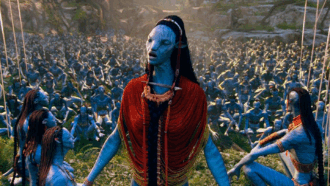Swedish Rhapsody
Celebrations honoring the world's top scientists brought students from many countries to Sweden to tour, learn, talk, and party.
Share this:
- Share via email (Opens in new window) Email
- Click to share on Facebook (Opens in new window) Facebook
- Click to share on X (Opens in new window) X
- Click to share on Pinterest (Opens in new window) Pinterest
- Click to share on Reddit (Opens in new window) Reddit
- Share to Google Classroom (Opens in new window) Google Classroom
- Click to print (Opens in new window) Print
By Emily Sohn
It was a busy, busy week, jam-packed with fun, ceremony, and science.
Twenty-four young people from 16 countries around the world were in Stockholm, Sweden. They were there to take part in the Stockholm International Youth Science Seminar (SIYSS).
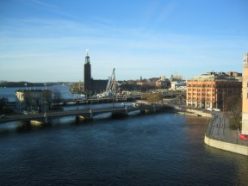 |
|
A view of Stockholm, Sweden, during the very few hours of daylight on a sunny day in December. |
| Emily Sohn |
The students went on field trips, made presentations, talked, danced, ate—and barely slept. To top it off, they had the chance to meet and chat with some of the world’s top scientists.
Each year, the Nobel Prizes honor the world’s most important accomplishments in fields ranging from physics to peace. In 2004, the winners received their awards at a grand ceremony in Stockholm on Dec. 10. And the SIYSS students were there.
Skipping sleep
Getting to Sweden for the seminar took a lot of hard work.
To earn a spot in the group, each student participant had to be a winner at a major national or international science fair. Or, students had to impress their schools and countries with the strength of their scientific research.
The seminar schedule included a day of presentations that required each young scientist to describe his or her research. The audience included not only the rest of the group but also a large number of Swedish high school students. This made many of the participants extremely nervous.
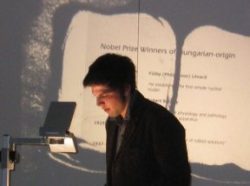 |
|
Balint Bartfai of Hungary makes a presentation. |
| Emily Sohn |
Colette Janse van Vuuren, for example, was still trying to review her notes at 1:04 a.m. on the morning before the presentations. Hester Baverstock sat nearby reading a book. Collete, 18, had come from South Africa, and Hester, 19, was from Great Britain.
The students knew it was important to prepare. But conversation kept distracting them. They discussed learning disabilities. They described their plans for the future. Hester talked about how hard it was for her to choose between medicine and literature. Colette talked about how she is left-handed but fences with her right arm.
Then, Hannah Higgins, an 18-year-old from Australia, came by and announced that she had won a college scholarship. Soon, Louk Rademaker, also 18, from the Netherlands, sat down to chat. Studying would have to wait.
“I feel like it’s just as important to stay up all night talking as it is to do all the science stuff,” Hester told me at breakfast in our hostel one morning.
Skipping sleep became a theme of the week. The group would spend all day touring and learning. Then, most of the students would while away the twilight hours discussing one another’s cultures, religions, and dreams. They danced, laughed, ate cookies, and played games. “People who are sleeping are really missing out,” Hester said.
Prize-winning science
Science took center stage during the daytime. And the Nobel Prize was the star of the week.
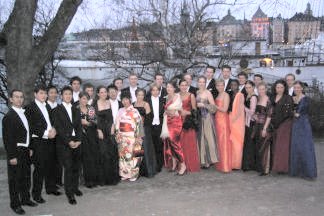 |
|
The 24 students from around the world attending the Stockholm International Youth Science Seminar braved the cold to pose for this photo. Dressed in formal clothes, they were about to set off for the banquet and ball, a big part of the Nobel Prize festivi |
| Emily Sohn |
One day, the students visited the Royal Swedish Academy of Sciences. Academy committees pick the winners of the chemistry and physics prizes.
In 2004, the Nobel Prize in Chemistry went to Aaron Ciechanover and Avram Hershko of Israel and Irwin Rose of the United States. These scientists had done research on how cells break down proteins.
The Nobel Prize in Physics went to David Gross, H. David Politzer, and Frank Wilczek of the United States. Their work dealt with the weird forces that keep the smallest building blocks of matter from flying apart.
At the Karolinska Institute, Hans Jornvall explained how winners are selected for the prize in medicine or physiology. The selection process is highly secretive, he said.
For a full year, the prize committee accepts nominations, does an enormous amount of research, narrows down the field of candidates, then votes on who should be the winners. The committee’s goal is to select scientists whose discoveries have most changed our understanding of the world.
“The world should not be the same after the discovery as it was before,” Jornvall said. “Our goal is to find the best discoveries each year, and that’s what we do.”
In 2004, the Nobel Prize in Medicine or Physiology went to Linda Buck and Richard Axel of the United States. These researchers made important discoveries about how our sense of smell works.
Nobel history
The first Nobel Prize was given out in 1901.
 |
|
Emily at the Royal Swedish Academy of Sciences, where committees vote on who should receive the physics and chemistry Nobel Prizes. |
The awards are named after Alfred Nobel, a Swedish scientist who invented dynamite. The factories and laboratories Nobel founded during his lifetime made him a rich man. When he died in Italy in 1896, he donated his entire fortune to the creation of prizes in physics, chemistry, physiology or medicine, literature, and peace. Economics was added later.
“Nobel was ahead of his time,” Jornvall said. “He wanted science and peace and literature all to be advanced. With five subjects, there was something for everyone.”
Each prize winner gets a gold medal. In 2004, the winners in a given field also shared the sum of $1.3 million.
The award ceremonies always occur on Dec. 10, the anniversary of Nobel’s death. They are followed by a grand party.
Crossing borders
The Nobel Prizes are awarded to people, not countries. The SIYSS also tries to focus on people. By spending a week together, students from different parts of the world learn that ideas can cross boundaries and connect them.
One afternoon seminar dealt with science and ethics. The participants were pushed to reflect on their responsibilities as scientists.
“You are the elite, the best scientists from these countries,” Hanna Sjögren said. She’s a 23-year-old medical student who helped organize SIYSS. “You’re responsible for how the world is going to be,” she said. “What’s the world going to look like? What’s the future going to be?”
As part of the exercise, the students were asked what they would do with a grant of $100 million. The young scientists came up with all sorts of ideas. Some proposed the creation of an international science organization to help build bridges between nations. Others thought about research, especially if they could pool their resources and work together toward a common goal.
“We should all get together and start a company!” Hannah said. “We could cure AIDS or something.”
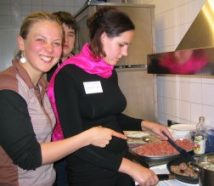 |
|
Hannah Higgins (left) of Australia and Colette Janse van Vuuren of South Africa learn to cook Swedish meatballs. |
| Emily Sohn |
To round out their activities, the group attended science lectures and visited laboratories and museums. The students saw where the famous scientists Carl Linnaeus, Anders Celsius, and Anders Angström once worked.
The group also toured the Swedish Parliament and went to the Royal Palace, where the students met Crown Princess Victoria and Princess Madeleine. Among other activities during the week, they enjoyed a traditional Swedish sauna and learned how to cook typical Swedish foods.
Youth science
Months of planning went into the SIYSS, and it was all done by enthusiastic, dedicated volunteers who are members of the Swedish Federation of Young Scientists (FUF, in Swedish). To belong to FUF, members must be 25 years old or younger.
When the participants were in town, the seminar coordinators worked around the clock, even though it was exam time for most of them. And Sjögren’s earlier efforts to make connections in new countries had been rewarded when Louise Nandawula Mpagi, 20, came all the way from Uganda to participate.
Both the coordinators and the participants shared a passion for science. They all took advantage of chances to meet (and even party with) the Nobel Prize winners, or Laureates.
The Laureates, in turn, enjoyed sharing bits of wisdom and inspiration with the next generation of researchers.
“To me, science is not a means to an end,” Axel said. “It’s an end unto itself.” Axel is a medical researcher at Columbia University in New York City.
“Science is a privilege and a joyous obsession,” he said. “It’s the best job in the world. A person spends one’s life thinking about fascinating problems both in life and in the world. One should take enormous pleasure in solving the problems of the world.”
“I feel very fortunate to be a scientist,” Buck added. She’s a medical researcher at the University of Washington in Seattle. “It’s wonderful to win a Nobel Prize, but it’s more wonderful to live life as a scientist.”
World links
By the time the festivities honoring the new Laureates were over, the students were tired but still reluctant to go home. They were grateful for all they had experienced in Stockholm.
Over the next few days, e-mails flew back and forth among members of the group.
“Isn’t it wonderful that in a world with such a lot of hatred, so many wars, and an increasing anonymity, young people with different religions, interests, and cultures could live in peace, [and] even more than that, [create] a strong cohesion?” wrote Flurin Cathoma, a 19-year-old from Switzerland. “This thought gives me a real hope for us and our future!!!”
Alfred Nobel would have been pleased to know that.
Going Deeper:
News Detective: Nobel Festivities
